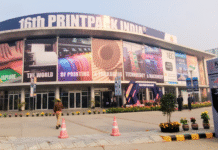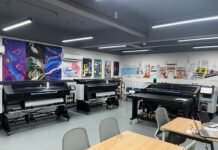
RMGT’s stand at IGAS 2022 was dominated by a 970 PF8 offset press, an 8-colour machine with perfector and online color control registration and inspection. The press was configured with a simultaneous plate change system, which Vinay Kaushal, director of RMGT’s Indian distributor Provin Technos, says represents the first generation to feature man-less printing.
This was demonstrated as part of RMGT’s Smart Factory concept where all the operations from prepress to the immediate post-press are linked together and automated. Toshiyuki Ishibashi, group leader for RMGT’s international sales and marketing, explains, “Many Japanese printing companies are facing small lot jobs with a lot of images. Plus the rising cost of materials and a lack of manpower.”
The Smart Factory brings together a number of companies, including Fujifilm for CtP and Horizon for post-press functions such as folding and binding. Ishibashi says that the purpose is to solve problems collaboratively for their customers rather than to charge more.
Thus a prepress workflow and MIS can send data to preset the press, as well as to the platesetter to make the plates. The practical demonstration at the show started with two autonomous guided vehicles, known as Nippers. One of these collected the plates from the platesetter and delivered them to the press. The smaller Nipper robot then picked up a palette with the paper and inserted that into the pile feeder for the press. The advantage of these small robotic systems is that they reduce the number of pressroom staff needed without the need for any kind of conveyor system.
The press itself was fitted with a prototype Plate Supply System on the 7th and 8th color units that removed the used plates from the print units and inserted the new plates that had been delivered by the Nipper. After printing, this Nipper AGV then took the printed sheets to Horizon’s stand for folding and binding.
For now, this level of automation has been designed for the Japanese market though it will be rolled out worldwide later. Vinay Kaushal says that the degree of automation will depend on the market. He points out that affordable labor for loading paper and plates is not a big issue in India, but adds, “The press automation will be popular because of the increase in productivity and that leads to an increase in profitability.”

Photo Nessan Cleary
The 970 press was first announced in 2020. It takes A1-plus sheet sizes with maximum paper size of 650 x 965 mm. This format is said to be growing in popularity worldwide because it’s cheaper to operate than B1. The 970 is available as a straight press or perfector, with two to ten color units. The 8-color perfecting version shown at IGAS was configured for LED-UV ink. It runs at up to 15,000 sph. It’s highly automated, using Smart Assist Printing systems to automatically set the ink presets, blanket cleaning, and plate changing to test printing, register alignment, density adjustment, and production printing. There’s an optional Print Quality System that uses an inline CCD camera











